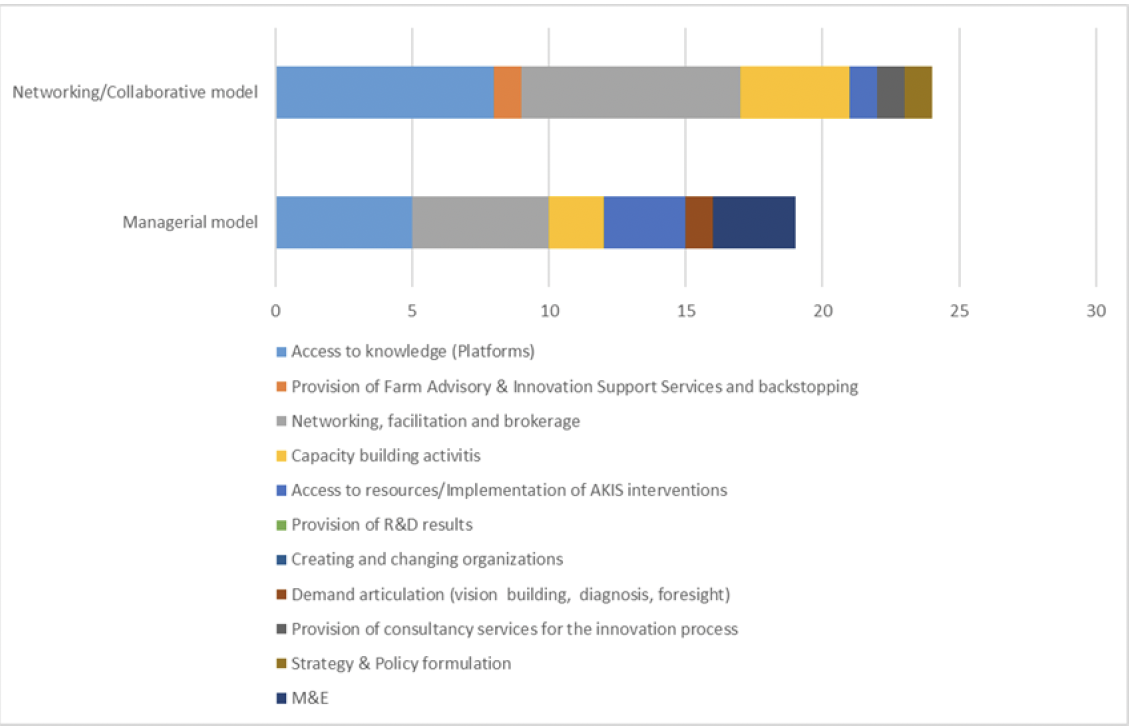
Go back
AKIS coordination bodies
governance
The institute of the AKIS-CBs represent the first attempt, within the European policies, to identify an institutional structure in charge of creating an enabling environment for innovation. Indeed, the introduction of this institute comes along with the acquisition of policy dignity of the AKIS and their strategies, which main goal is to strengthen the agricultural systems in rural areas and contribute to more competitive and sustainable primary sector in Europe (Cristiano et., al, 2023; D1.1).
So that, AKIS coordinating bodies (AKIS-CB) are new governing actors of the CAP SPs 2023-2027, which responsible are identified under chapters 8 of the CAP SPs and which overall goal is to enable the environment for well-functioning AKISs, through fostering cooperation, effectively combining the interventions of the CAP Strategic Plans and satisfying the need for a quicker, more qualitative and more inclusive AKIS.
Indeed, as it emerges from the study on the comparative analysis of the AKIS in EU (Fanos et al. 2023; D1.10), “the managing authorities play a pivotal role in strategizing the AKIS coordination and serving as the umbrella organization”. While the strategic coordination tasks are taken up by the managing authorities, multiple approaches/models are observed across the CAP-SPs for the operational coordination tasks.
Firstly, the different institutional configuration of MSs, with some having the competence for the primary sector at national and some at regional levels makes some difference, by shaping more centralized or decentralized approaches to AKIS coordination. For example, “in MSs with a decentralized AKIS organization, particularly Germany, Italy and Spain, role of and facilitate knowledge exchange between the regions” (Birke et al. 2023; D1.10). AKIS-CBs at the national level is dedicated to bringing regional or provincial AKIS coordination bodies together by setting up a working group or an advisory board in which the group proposes an overall strategy.
As a matter of fact, the only reference to the responsibilities and tasks of AKIS CBs is provided by the Tool 8.1 “Tool for the CAP Cross-Cutting Objective” (EC, 2021) that proposes the followings:
Box 1: AKIS governance levels across EU
The organisation of national AKISs and the degree of public sector engagement in the AKIS governance entail differences in how AKIS-CBs may implement their coordination tasks:
- AKIS-CBs in a centralized AKIS governance with strong engagement of managing authorities may have a more focused mandate at the national level with a well-defined hierarchical structure that also influences the coordination efforts.
- AKIS-CBs in a centralized AKIS governance with medium or low engagement of managing authorities need to navigate their coordination by aligning between the state and non-state structures, which may be diverse and flexible.
- AKIS-CBs in a decentralized AKIS governance will need to facilitate coordination among diverse regional actors while aligning with the strategies at the national level.
- AKIS–CBs in a hybrid AKIS governance (centralized with a tendency for decentralization), similar to those in a decentralized AKIS need to facilitate coordination among regional actors while aligning to the strategies at the national level.
(Birke et al. 2023)
However, beyond the institution and the identification of some tasks, the coordination of the AKIS is a strategic process of systems functioning and transformation. Consequently, governance models in MSs should be appropriately defined by including clear a definition of role, responsibilities, and approaches, along with capacity development strategies that would enable these bodies playing an overall process of coordination of the AKIS and their actors towards the good implementation of the respective strengthening strategies.
“The challenge lies in strategically aligning knowledge exchange and collaboration between diverse actors at various levels” (Birke et al. 2023; D1.10). All in all, the configuration of appropriate models of AKIS coordination bodies should consider that some key processes should be organized under their responsibility in view of enabling the environment for effective knowledge flows and innovation towards well-functioning AKISs (Cristiano et al., 2023; D1.1, Annex 2). Among them, the AKIS-CB should balance, according to the contextual situation of the AKIS, the roles of “player” with the one of “enabler” as shown in Table 1.
The practices reported in this "Compendium" show a tentative to profile the AKIS coordination bodies, that certainly include the definition of the responsibility, the configuration of the (individual/collective) responsible body and some key functions. Still, the procedures and mechanisms for effectively operationalise the functions attributed to the AKIS coordination bodies are less defined, except that for the one case of pre-existing collective body (i.e. Sardinia Region).
A preliminary insight about the different organization models and functions described by the CAP SPs, and as deepened in the AKIS-in-practices! that are included in this Compendium, is that apparently, in general, two governance models are being applied (Figure 1: AKIS coordination bodies’ models in EU):
Figure 1: AKIS coordination bodies’ models in EU (n./tot)

Source: own elaboration from CAP Strategic Plans
The results of the observation on the first modelling and approaching the AKIS-CBs, brings some reflections on the needs for capacity building and networking activities that can be certainly considered in modernAKIS: